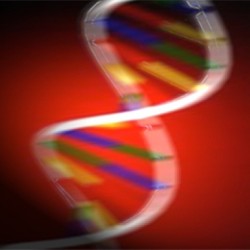By Helen Figueira
August 13, 2010
Time to read: 5 minutes
 Gene Regulation and Chromatin: gene priming in ES cells
Gene Regulation and Chromatin: gene priming in ES cells
Pluripotent embryonic stem (ES) cells can give rise to any of the multitude of cell types in the body, making them an exciting prospect for generating replacement cells for use in regenerative medicine. One of the properties thought to give these cells their remarkable plasticity is the priming of genes – making it easier for them to be switched on when the cells differentiate along specialised lineages. A good analogy is the difference between a car sitting at a red traffic light with its engine revved up, and trying to start a car from cold on a frosty winter morning.
A study carried out by the Gene Regulation and Chromatin Group, led by Niall Dillon, has provided new information on the mechanisms behind gene priming.
The results, which were published in Cell Stem Cell, show that ES cell transcription factors are directly involved in gene priming. These factors, which include Sox2, Oct4, Nanog and Foxd3, are involved in specifying the programme of genes that are expressed in pluripotent ES cells. What this study shows is that some of them are also involved in priming tissue-specific genes for expression at later stages of cell differentiation.
The researchers found that ES cell factors Sox2 and Foxd3 bind to a tissue-specific enhancer within the λ5–VpreB1 locus. In ES cells the λ5 and VpreB1 genes are silent, but they are switched on during B cell development, where they play an important role in controlling cell proliferation. Although switching on of the genes occurs late in this process, the enhancer is already marked by active histone modifications in ES cells. These modifications are specifically targeted to the enhancer by Sox2, one of the four factors used to generate pluripotent stem cells. Foxd3, which also binds to the region, seems to have a different role in damping down permissive transcription of the region in ES cells. Once the ES cells begin to differentiate, Sox2 is switched off, but in cells that progress towards the B cell lineage, another related factor, Sox4, takes over the role of maintaining the enhancer in an active state. In pre-B cells, Sox4 is involved in activating full expression of the genes. A similar switch in factor binding was observed at the Pax5 gene, which plays a key role in specifying B cell identity.
These results suggest priming of enhancers occurs through a transcription factor relay, with ES cell factors binding to tissue-specific enhancers and then handing over to related factors that bind to the same sites as cells differentiate. The transcription factors work in conjunction with histone modifications to keep genes in a primed state, ready to be switched on at the precise time and developmental stage where they are needed for correct cell differentiation.
Gene Regulation and Chromatin: gene priming in ES cells
Pluripotent embryonic stem (ES) cells can give rise to any of the multitude of cell types in the body, making them an exciting prospect for generating replacement cells for use in regenerative medicine. One of the properties thought to give these cells their remarkable plasticity is the priming of genes – making it easier for them to be switched on when the cells differentiate along specialised lineages. A good analogy is the difference between a car sitting at a red traffic light with its engine revved up, and trying to start a car from cold on a frosty winter morning.
A study carried out by the Gene Regulation and Chromatin Group, led by Niall Dillon, has provided new information on the mechanisms behind gene priming.
The results, which were published in Cell Stem Cell, show that ES cell transcription factors are directly involved in gene priming. These factors, which include Sox2, Oct4, Nanog and Foxd3, are involved in specifying the programme of genes that are expressed in pluripotent ES cells. What this study shows is that some of them are also involved in priming tissue-specific genes for expression at later stages of cell differentiation.
The researchers found that ES cell factors Sox2 and Foxd3 bind to a tissue-specific enhancer within the λ5–VpreB1 locus. In ES cells the λ5 and VpreB1 genes are silent, but they are switched on during B cell development, where they play an important role in controlling cell proliferation. Although switching on of the genes occurs late in this process, the enhancer is already marked by active histone modifications in ES cells. These modifications are specifically targeted to the enhancer by Sox2, one of the four factors used to generate pluripotent stem cells. Foxd3, which also binds to the region, seems to have a different role in damping down permissive transcription of the region in ES cells. Once the ES cells begin to differentiate, Sox2 is switched off, but in cells that progress towards the B cell lineage, another related factor, Sox4, takes over the role of maintaining the enhancer in an active state. In pre-B cells, Sox4 is involved in activating full expression of the genes. A similar switch in factor binding was observed at the Pax5 gene, which plays a key role in specifying B cell identity.
These results suggest priming of enhancers occurs through a transcription factor relay, with ES cell factors binding to tissue-specific enhancers and then handing over to related factors that bind to the same sites as cells differentiate. The transcription factors work in conjunction with histone modifications to keep genes in a primed state, ready to be switched on at the precise time and developmental stage where they are needed for correct cell differentiation.
This work was published in Cell Stem Cell